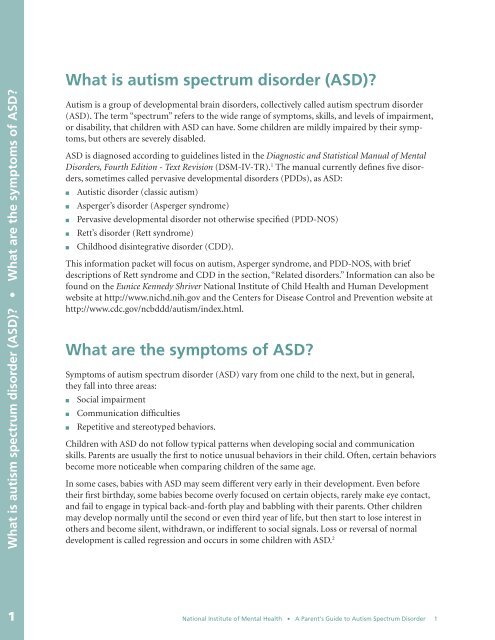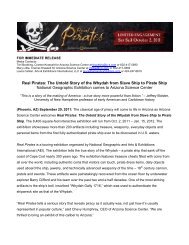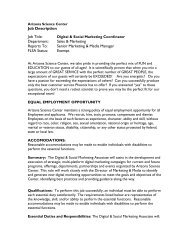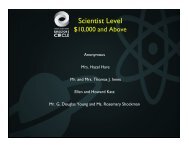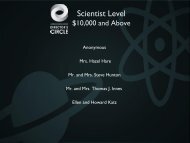A Parent's Guide to Autism Spectrum Disorder - NIMH - National ...
A Parent's Guide to Autism Spectrum Disorder - NIMH - National ...
A Parent's Guide to Autism Spectrum Disorder - NIMH - National ...
Create successful ePaper yourself
Turn your PDF publications into a flip-book with our unique Google optimized e-Paper software.
What is autism spectrum disorder (ASD)? • What are the symp<strong>to</strong>ms of ASD?<br />
What is autism spectrum disorder (ASD)?<br />
<strong>Autism</strong> is a group of developmental brain disorders, collectively called autism spectrum disorder <br />
(ASD). The term “spectrum” refers <strong>to</strong> the wide range of symp<strong>to</strong>ms, skills, and levels of impairment,<br />
or disability, that children with ASD can have. Some children are mildly impaired by their symp<strong>to</strong>ms,<br />
but others are severely disabled.<br />
ASD is diagnosed according <strong>to</strong> guidelines listed in the Diagnostic and Statistical Manual of Mental <br />
<strong>Disorder</strong>s, Fourth Edition - Text Revision (DSM-IV-TR). 1 The manual currently defines five disorders,<br />
sometimes called pervasive developmental disorders (PDDs), as ASD:<br />
n Autistic disorder (classic autism)<br />
n Asperger’s disorder (Asperger syndrome)<br />
n Pervasive developmental disorder not otherwise specified (PDD-NOS)<br />
n Rett’s disorder (Rett syndrome)<br />
n Childhood disintegrative disorder (CDD).<br />
This information packet will focus on autism, Asperger syndrome, and PDD-NOS, with brief<br />
descriptions of Rett syndrome and CDD in the section, “Related disorders.” Information can also be <br />
found on the Eunice Kennedy Shriver <strong>National</strong> Institute of Child Health and Human Development <br />
website at http://www.nichd.nih.gov and the Centers for Disease Control and Prevention website at <br />
http://www.cdc.gov/ncbddd/autism/index.html.<br />
What are the symp<strong>to</strong>ms of ASD?<br />
Symp<strong>to</strong>ms of autism spectrum disorder (ASD) vary from one child <strong>to</strong> the next, but in general,<br />
they fall in<strong>to</strong> three areas:<br />
n Social impairment<br />
n Communication difficulties<br />
n Repetitive and stereotyped behaviors.<br />
Children with ASD do not follow typical patterns when developing social and communication <br />
skills. Parents are usually the first <strong>to</strong> notice unusual behaviors in their child. Often, certain behaviors <br />
become more noticeable when comparing children of the same age.<br />
In some cases, babies with ASD may seem different very early in their development. Even before <br />
their first birthday, some babies become overly focused on certain objects, rarely make eye contact,<br />
and fail <strong>to</strong> engage in typical back-and-forth play and babbling with their parents. Other children <br />
may develop normally until the second or even third year of life, but then start <strong>to</strong> lose interest in <br />
others and become silent, withdrawn, or indifferent <strong>to</strong> social signals. Loss or reversal of normal <br />
development is called regression and occurs in some children with ASD. 2<br />
1 <strong>National</strong> Institute of Mental Health • A Parent’s <strong>Guide</strong> <strong>to</strong> <strong>Autism</strong> <strong>Spectrum</strong> <strong>Disorder</strong> 1


